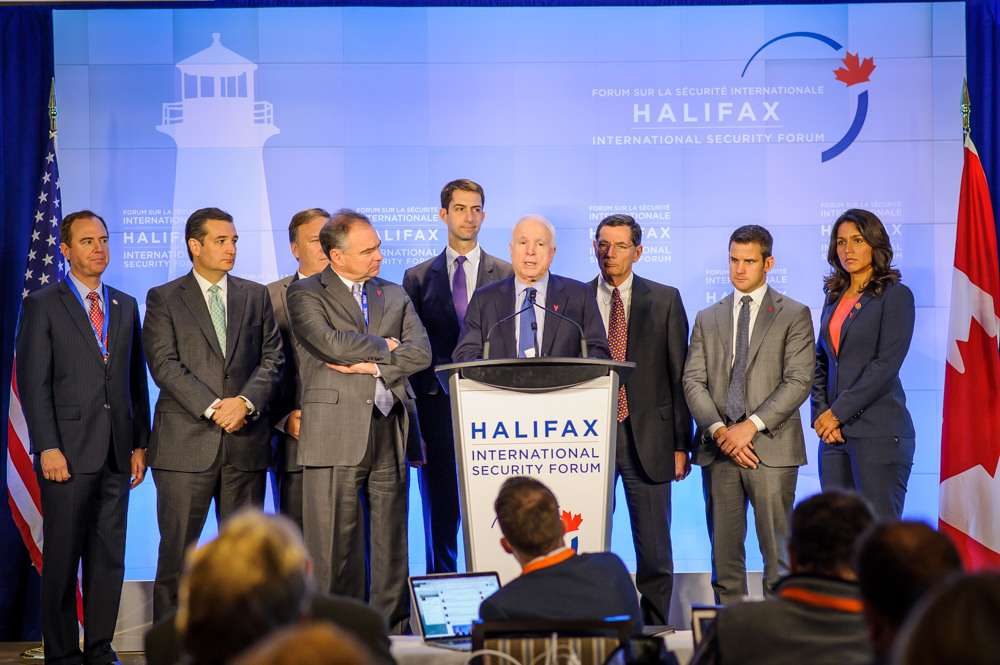The GOP's Budgetary Shenanigans Discourage Necessary Pentagon Reform
The Department of Defense will continue to avoid hard choices if the war hawks prevail and gut spending caps.

The civil war being fought within the Republican Party over Pentagon spending came to a head this week, as the House Budget Committee proposed a spending level technically in line with Budget Control Act (BCA) limits, but that actually skirts those caps by loading additional monies into the overseas contingency operations (OCO) account.
Pentagon spending boosters are likely to claim victory. It is actually a defeat for fiscal responsibility and strategic good sense. Busting the budget caps virtually ensures that necessary reforms within the Pentagon will be kicked down the road, and likewise discourages a serious reconsideration of the military's roles and missions. And the committee's shenanigans clearly defy the spirit of the BCA, which is rightly credited with slowing the growth of government.
U.S. military spending—the Pentagon's base budget, excluding the cost of our recent wars—remains near historic highs. Under the bipartisan BCA caps passed in 2011, U.S. taxpayers will still spend more on the military (in inflation-adjusted dollars) in each of the next five years than we spent, on average, during the Cold War.
But Sen. John McCain (R-Ariz.) and Rep. Mac Thornberry (R-Texas), the respective chairs of the Senate and House Armed Services Committees, think we're spending too little. In a widely cited op ed in the Wall Street Journal last week, they called on Republicans to support a $577 billion defense budget, or $78 billion more than the BCA limits. Tom Cotton faulted McCain and Thornberry for being too stingy. The nation's survival, Arkansas's freshman senator suggested in his first floor speech, would be dangerously imperiled if we didn't spend at least $611 billion next year, plus whatever extra was needed to fight the nation's wars.
McCain, Thornberry, and Cotton want much more military spending because they believe the world is too dangerous, and the U.S. military is too small to deal with the dangers. But today's threats are relatively modest and manageable compared with our recent past. And while the U.S. military is smaller than in 2010, or 1990, it is not necessarily too small.
Consider the question just in terms of the number of men and women serving on active duty. In 1952, at the height of the Korean War, active duty personnel peaked at 3.6 million. In 1968, during the Vietnam War, the number of active duty personnel reached 3.5 million. The high point in the post-Cold War era came in 2010, when active duty personnel peaked at 1.5 million, less than half the total in uniform at the time of those earlier wars. And yet total Pentagon spending in 2010—again, in inflation-adjusted dollars—was 35 percent higher than in 1952, and 32 percent higher than in 1968.

A similar story could be told with respect to ships at sea, or planes in the air.
The platforms we are buying today are more costly than those fielded a generation ago. We appear to be spending more, and getting less. But appearances can be deceiving.
The Cold War military was comprised primarily of conscripts obligated by law to serve, often against their will. They were poorly paid and they received minimal training. They executed the missions they were given, but they were, by and large, temporary soldiers, anxious to return to their lives when their obligated term of service was up.
Today's military consists of hundreds of thousands of dedicated professionals who have chosen to serve in the military, often for a career. We are more willing to invest heavily in their training, confident that those investments will pay dividends over the long term. Their pay and benefits are commensurate with a professional force and attract the very best talent.
So, yes, we spend a lot. But it isn't necessarily true that we are getting less for what we spend, and it isn't obvious that a Pentagon budget averaging more than a half a trillion dollars a year is woefully insufficient to defend this country, and our vital interests.
Meanwhile, no one disputes that there is waste in the Pentagon's budget. The Pentagon has too much overhead, too many people, and too many underutilized bases and other facilities. The military's compensation system is antiquated and desperately in need of reform. The Pentagon's program for acquiring new weapons is similarly outdated and inflexible. McCain and Thornberry, even as they call on the taxpayers to increase military spending by 15 percent, freely admit that not every dollar that the Pentagon spends today is spent wisely. "Of course there is waste in the Pentagon," they write, "and efforts to eliminate it must continue. But sequestration does not target Pentagon spending. It cuts spending recklessly."
What they do not say, however, is that sequestration's "goofy meat axe" (Leon Panetta's evocative phrase) only falls if Pentagon leaders refuse to abide by the BCA spending caps. If they submitted a budget that adhered to those limits, or, more accurately, if Congressional appropriators compelled them to do so, then the cuts could be targeted.
Our government—including both DoD and the Congress—has chosen to ignore a package of cost-saving reforms that a diverse coalition of defense experts endorsed nearly two years ago. And they will continue to avoid those hard choices if the war hawks prevail and gut the BCA spending caps.


Show Comments (38)